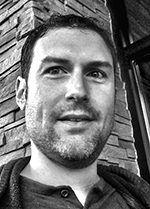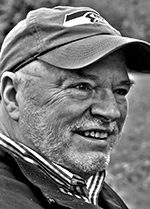Every year nearly 800,000 people in the U.S. suffer a stroke. One of these people was a woman I knew. At her funeral, I discovered that she was only 67—five years older than me. So when I went to the Harborview Stroke Clinic to interview physicians and patients for this story, my interest became personal.
The people in the waiting room on the fifth floor of Harborview’s Ninth and Jefferson Building looked like me. They were aged 50 to 70. They didn’t have noticeable deficits. No one was crumpled in a wheelchair or struggling to talk. It was then and there that I knew I was ripe for a stroke. I have high blood pressure. I am overweight. I do exercise vigorously but I am a meat-eating, cheese-loving, sugar-savoring, at-risk American devouring the Standard American Diet. The following week, during a routine dental appointment, the assistant took my blood pressure.
A normal reading is 130 over 80. Mine was 166 over 96, which surprised me because I take medication for hypertension. So I bought a wrist monitor and tracked my blood pressure at home for 10 days. It was consistently high, once reading 166 over 100. Yikes.
I asked Stroke Clinic Director Kyra Becker, “What does a person need to do to prevent stroke?” Her answer: Exercise regularly, eat a Mediterranean-style, mainly plant-based diet (nuts, seeds, fish, olive oil) and make sure blood pressure is aggressively controlled. If you smoke, stop. Get your cholesterol checked; if it’s too high, medication can help.
Taking personal responsibility for one’s health is essential but that alone won’t guarantee your well-being; fully one-quarter of all strokes are cryptogenic, meaning there is no known cause.

Mike Vargas, 36
Mike Vargas is a prime example. At 36, he looks like the picture of health. Yet Vargas, a video game developer, has suffered two strokes, cause unknown. His second stroke in 2013 earned him two nights in the hospital. After a battery of tests, his physician referred him to Harborview because of its reputation for excellent stroke care.
At Vargas’ latest visit to Harborview on a sunny July day, David Tirschwell, the Stroke Center’s medical director, reviews scans of Vargas’ head. While the carotid arteries (the ones that lead to the brain) look clear, Tirschwell detects a slight abnormality in one. “We are going to take a look with our neuroradiology specialist, have a consult about this,” says Tirschwell. Blood tests will be ordered to see if Vargas has a genetic tendency to form blood clots.
For the past year, Vargas, ’01, has been a model patient. Following Becker’s advice, he has dropped 40 pounds and works out most days. Yet he still feels scared when he experiences any abnormal sensations in his head.
In 2011, 2,554 people died from strokes in Washington state. So where people seek treatment is critical to their survival and recovery. Harborview is the only comprehensive stroke center certified by the Joint Commission that serves Washington, Wyoming, Alaska, Montana and Idaho. That’s why the Stroke Clinic received referrals from 218 different medical sites in 2014.
There’s good reason why Harborview is so highly acclaimed. It boasts six of the top interventional neuroradiologists in the world as well as six of the state’s 10 specialists trained to use a device that works like a vacuum cleaner to remove blood clots from the arteries in the brain.
This treatment—which takes about 20 minutes—is so effective that “recent studies have shown that in 50 percent of cases, blood vessels return to normal,” says Louis Kim, Harborview’s chief of neurological surgery. UW Medicine specialists also can employ a stent retriever that works like a trap to smoosh blood clots to the artery wall and then suck them out. Once blood clots are removed, blood can flow freely again to the brain. That can shorten rehabilitation and lessen the effects of a severe stroke.
“Every minute you are having a stroke, you are losing tens of thousands of brain cells.”
Louis Kim, Harborview chief of neurological surgery
While these high-tech devices can work wonders, patients must first receive a clot-busting drug called tPA, preferably in the first three hours after suffering a stroke. “Every minute you are having a stroke, you are losing tens of thousands of brain cells,” says Kim. Calling 911 and getting to the hospital fast is essential. Says Peter Esselman, ’75, ’79, professor and chair of the Department of Rehabilitation Medicine: “Too often with stroke, people will go to bed and say ‘this will feel better in the morning,’ but by the time they get to Harborview the damage is done.”
***

Neil Scott, 69
Neil Scott is an example of a stroke victim who didn’t seek treatment immediately. Scott, a young-looking 69-year-old Seattle-based radio broadcaster, is a dedicated runner who has put in at least a mile a day for the past 11 years. One day last summer, while out on his daily constitutional, Scott noticed weakness in his left side. Having already experienced two strokes, he figured he should get to Harborview. But he didn’t call for an ambulance.
“I took the bus,” he says. “I would have been embarrassed to call 911 and have an ambulance come take me away.” While Scott was given tPA right away, he turned out not to be a candidate for a stent-retriever procedure because his stricken blood vessels were too small.
During a recent follow-up exam, he tells Tirschwell that his balance “is off a little bit” and that he has lost vision in his left eye. “Stroke is like real estate,” says Tirschwell, explaining variability in brain damage. “What matters is location, location, location.”
No matter what part of the brain is affected, Harborview has a stroke team available 24/7 for patients who come in with acute stroke. “We have a very large neuroscience intensive care unit staffed by expert clinicians,” Becker says. “And the stroke rehabilitation team offers a depth of experience that other institutions don’t have.”
Norm Beauchamp, professor and chair of radiology in the School of Medicine, explains: “Part of why I came to the UW [from Johns Hopkins University] is because this is an amazing place to innovate. It’s the best in the country because of the strength of the rest of the campus. The UW has brought together the best neurologists, neurointerventional radiologists and diagnostic radiologists, neurosurgeons, physicists, computer scientists and emergency room physicians.”
People with atrial fibrillation (AFIB)—a condition featuring rapid, irregular beating of the heart’s upper chamber—have a five times greater risk of stroke. When these contractions weaken, blood flow can slow and clots can form. Blood thinners can help. But they are a tricky proposition. Too little of this medication won’t thin the blood enough; too much can cause bleeding in the brain or elsewhere in the body. Then there are patients who can’t tolerate these medications at all.
Two UW Medicine physicians, Elizabeth Perpetua and Mark Reisman, are among the first in the U.S. to implant a medical device called the Watchman. Just approved by the Food and Drug Administration, the device is inserted into the left atria to prevent clots from traveling to the heart or the brain. This eliminates the need for anticoagulants altogether. Their patient, a 77-year-old Lake Stevens man, was among the first in the country to receive the device. He experienced four previous hospitalizations for gastrointestinal bleeds caused by the blood thinner he was taking. Now he shouldn’t have to worry about that again.
***
But UW faculty aren’t solely focused on treating stroke. Rehabilitation is just as important. That’s why scientists from the College of Engineering are collaborating with UW Medicine clinicians to find ways to make rehabilitation more effective. Kat Steele, assistant professor of mechanical engineering, is studying gait and analyzing body motion to find strategies for people who develop hip weakness (common after a stroke), spasticity and drop foot (difficulty lifting the top of the foot). Steele and her students are developing braces and other devices that correct alignment or provide support. The software products developed in this study at the Steele lab will be open source—free and available to all.
Brian Glaister, a former UW graduate student, founded a Seattle company, Cadence Biomedical, after completing a fellowship with UW’s innovation incubator, CoMotion. Its specialty: creating products for stroke rehabilitation. For instance, Glaister developed a mechanical-assist device called Kickstart to help patients regain the ability to walk. It looks a little like Robocop’s leg and foot, and works like an artificial tendon to assist proper leg advancement. A spring in the device helps propel the leg normally.
UW faculty aren’t solely focused on treating stroke. Rehabilitation is just as important.
This device completely transformed Donna Jang’s life. In 1992, Jang suffered a ruptured aneurysm in her brain. “The left side of my body didn’t work,” she says. “I had to learn how to walk again, but still I struggled to walk correctly. One of the key things I didn’t know is you need a hip flexor to walk. People who’ve had a stroke hike the hip and swing the leg.” (Hip flexors are a group of muscles that help a person flex or move the leg and knee up toward the body.) For 18 years, Jang walked with the ungainly gait of a stroke patient. That wore out the cartilage in her hips and put her in constant pain. She found out about Kickstart because she’s an angel investor who contributes to startups. Jang received the Kickstart prototype in March 2012. Within months, her pain was gone.
“The device doesn’t allow you to use your leg incorrectly. I was 60 years old and 18 years post-stroke, but after about 18 months, I believe that my brain developed new neural pathways to the hip flexor,” she says. Jang reached the pinnacle of her post-stroke life when she began ballroom dancing with her husband again. To this day, she remains pain free.
While Kickstart is already on the market, other promising research is under way to help stroke victims with mobility problems. The research team led by Chet Moritz, ’98, associate professor of rehabilitation medicine, is developing technology to bypass damaged areas in the nervous system (kind of like an end run in football) to restore control of paralyzed limbs. They are also promoting recovery and possible regeneration of damaged brain tissue.
But faculty at the UW don’t have a monopoly on stroke research. Four UW students—Brian Mogen, Tyler Libey, Dimitrios Gklezakos and Lars Crawford—won the Center for Sensorimotor Neural Engineering’s Tech Sandbox Competition by developing activities that combine therapeutic movements with advanced muscle and movement tracking. One example is a game like Whack-a-Mole, where patients pick up a virtual mallet to “whack” the computer image of a mole. The tasks increase in difficulty as patients make progress.
Rehabilitation is a difficult, frustrating process that has long plagued stroke victims. But these games track accomplishment and improvement, giving hope to patients and therapists alike. This technology is being tested at Harborview and at a Tacoma retirement community.
As for me, I’m eating a mostly vegetarian diet, vegan when I can. But occasionally I slip and eat a hamburger. Perfect is the enemy of the good, right? I am on a second blood pressure medicine and the hypertension is under control.